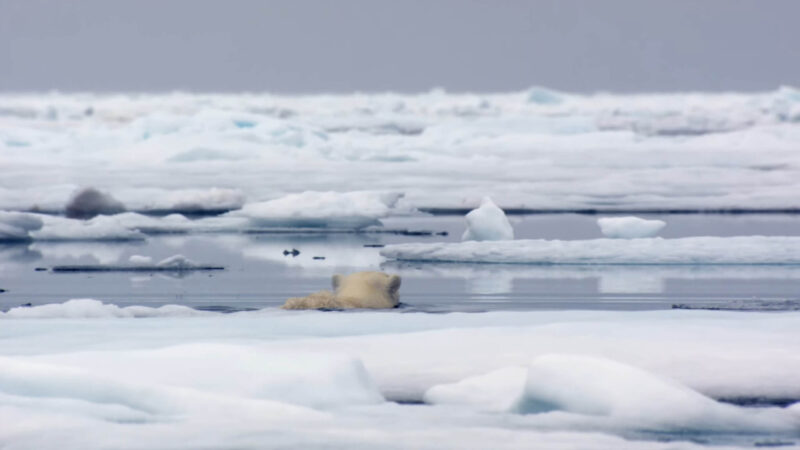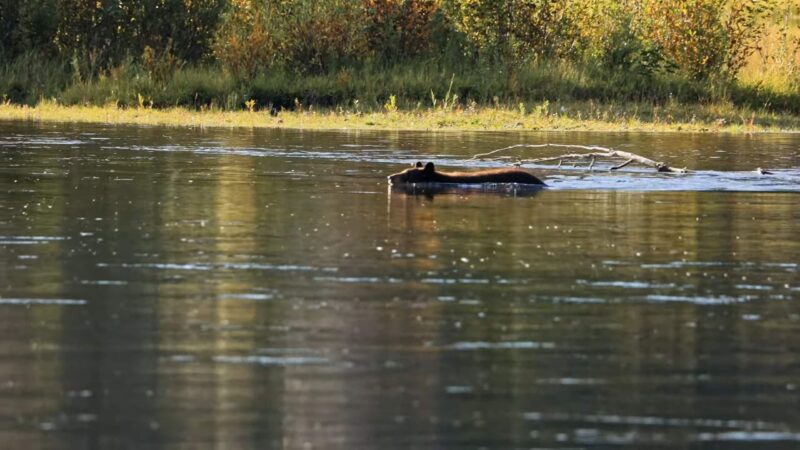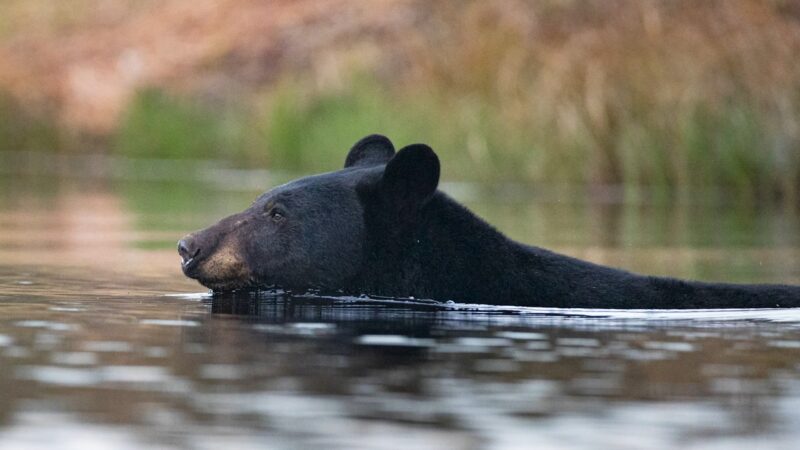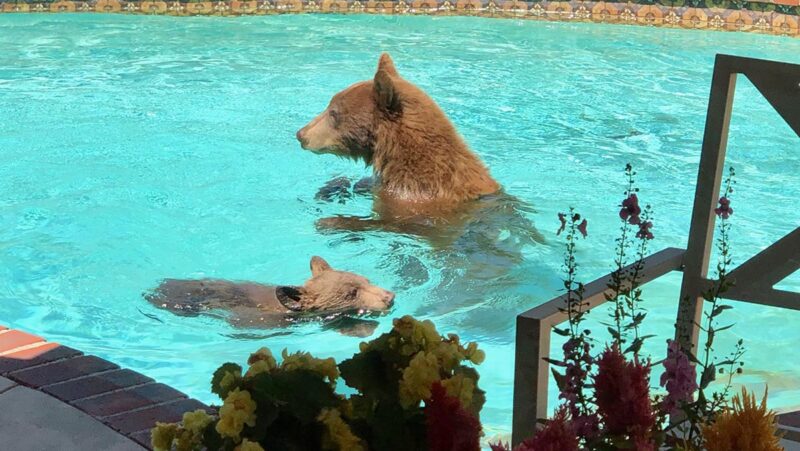Bears, often seen as emblematic of raw power and terrestrial might, harbor a surprising and lesser-known skill: swimming.
From the icy waters of the Arctic, where polar bears reign supreme, to the more temperate regions inhabited by brown and black bears, these mammals exhibit varying degrees of aquatic prowess.
Today, we will discuss the swimming abilities of different bear species, exploring how these capabilities intertwine with their survival strategies, diets, and habitats.
The Swimming Spectrum
The Polar Species

Polar bears, often regarded as marine mammals, are living proof of the aquatic adaptability of bears.
They possess the ability to swim at impressive speeds exceeding six miles per hour.
Their prowess doesn’t stop there, as they are known for their marathon swims, covering hundreds of miles between ice sheets.
What enables this remarkable endurance? A combination of factors, including their large size, significant fat content, and a well-adapted, oily coat, contributes to their ability to float and insulation in freezing waters.
Brown and Grizzly Species

Brown bears, including grizzlies, showcase a different set of swimming skills. While not as aquatic as their polar cousins, these bears are nonetheless adept swimmers.
Their high-fat content and oily coat play a crucial role, much like in polar bears, aiding in buoyancy and water resistance.
This adaptation is not just for survival; it is a testament to the evolutionary versatility of these animals. Brown and grizzly bears often swim across rivers and lakes, whether for hunting, foraging, or simply as a means of travel.
The Lesser-Known Swimmers: Black Bears and Pandas

Black bears and pandas, while less renowned for their swimming abilities, are no strangers to water.
Black bears, with a body shape similar to dogs, often perform a “doggy paddle” when swimming.
Their swimming is typically at a pace akin to their walking speed, suggesting a more casual approach to aquatic locomotion.
Pandas, on the other hand, can swim but rarely need to in their natural bamboo forest habitats. Their swimming is more out of necessity than habit.
Koalas
Koalas, one of the slowest species on the planet, although capable of swimming, struggle with this activity. Their challenges mainly arise when trying to exit the water, a task that proves more daunting for them compared to other bear species.
This lesser-known aspect of koala behavior highlights the diversity in swimming abilities among bear species, shaped by their unique evolutionary paths and environmental demands.
Swimming as a Survival Strategy
Polar Species
For polar bears, swimming is not just a skill but a vital survival strategy.
Their aquatic abilities allow them to hunt seals, their primary prey, and navigate the fragmented ice sheets of their Arctic habitat.
This need to swim is driven by the demands of their diet and the changing climate, which continually reshapes their icy environment.
Brown and Black Species
In contrast, brown and black bears exhibit more opportunistic swimming behaviors. They swim to access new areas, escape threats, or occasionally hunt.
Their swimming habits are shaped by the availability of food and the nature of their habitat, showcasing a more adaptable, less obligatory approach to swimming compared to polar bears.
Swimming as a Cub
Bear cubs, including those of polar bears, are introduced to swimming early in life.
This early exposure is crucial for their survival, particularly for polar bear cubs who must navigate a watery world from a young age.
The ability to swim is not just an inherited trait, but also a learned skill passed down from mother to cub.
What Science Claims
Bears possess a body shape that lends itself well to swimming. Their stocky, powerful builds are surprisingly buoyant, thanks to their fat content.
The “doggy paddle” swimming style seen in most bears is a natural outcome of their body structure, similar to that of canines.
The Role of Diet and Habitat
The diet and habitat of a bear significantly influence its swimming habits. Polar bears, reliant on marine prey, are frequent swimmers, while other bears, with more terrestrial diets, swim less often.
The necessity of traversing water bodies in their habitat also plays a role in determining how often and how well a bear swims.
Bear Swimming Techniques and Styles
The ‘Doggy Paddle’ Style
The ‘doggy paddle,’ a common swimming style observed in bears, is characterized by its simplicity and efficiency.
Bears use this style to navigate water bodies with ease, propelling themselves forward with coordinated movements of their front and back legs.
This technique is particularly suited to their body structure, allowing them to swim effectively without expending excessive energy.
Diving and Submerging Tactics
While bears are predominantly surface swimmers, some have been observed using diving tactics, especially when hunting or exploring underwater food sources.
These diving behaviors are more common in polar bears, who may submerge to catch prey or explore beneath ice sheets.
However, such behaviors are relatively rare and not a primary aspect of bear swimming techniques.
FAQs
Do bears enjoy swimming, or is it purely for survival?
They swim for various reasons, including survival, hunting, and sometimes even for pleasure. While some species swim primarily for survival and hunting, others, like black bears, may swim more casually, suggesting they might find it enjoyable.
Can bears swim underwater?
They can swim underwater, but they typically don’t do so for extended periods. They are more adept at surface swimming, using their powerful limbs for propulsion.
How do bears learn to swim?
Cubs learn to swim largely through instinct and by following their mothers. In species like polar bears, where swimming is essential for survival, cubs start learning at a very young age.
Are there any bear species that cannot swim?
All known species have some ability to swim. However, the extent and proficiency vary greatly among species, with some, like koalas, being less adept than others, like polar bears.
Do bears swim in both fresh and saltwater?
Yes, they are capable of swimming in both fresh and saltwater. Polar ones frequently swim in the ocean, while other species, like black and brown ones, often swim in rivers, lakes, and occasionally in coastal areas.
How do bears’ coats help them in swimming?
Their coats, especially in species like the polar bear, have unique properties that aid in swimming. The fur repels water and provides insulation, while their skin’s oil helps with buoyancy and reduces water resistance.
Final Words
The swimming abilities of bears are a fascinating aspect of their biology, reflecting their adaptability and resilience.
From the icy waters of the Arctic to the forested rivers of the temperate zones, bears have developed remarkable swimming skills that are crucial for their survival.
Knowing and respecting these skills, along with the environmental factors that influence them, is key to ensuring the continued existence of these incredible mammals in our rapidly changing world.
As we look to the future, it’s imperative that we continue to support and advance efforts that protect bear habitats and promote coexistence between humans and these extraordinary creatures.








